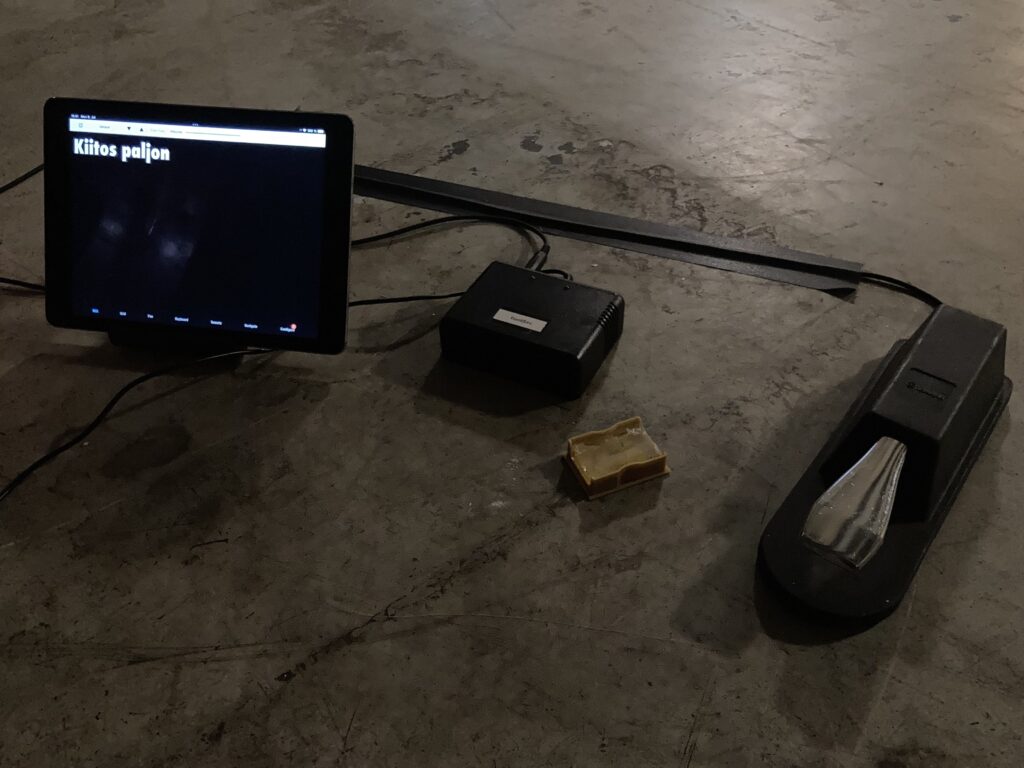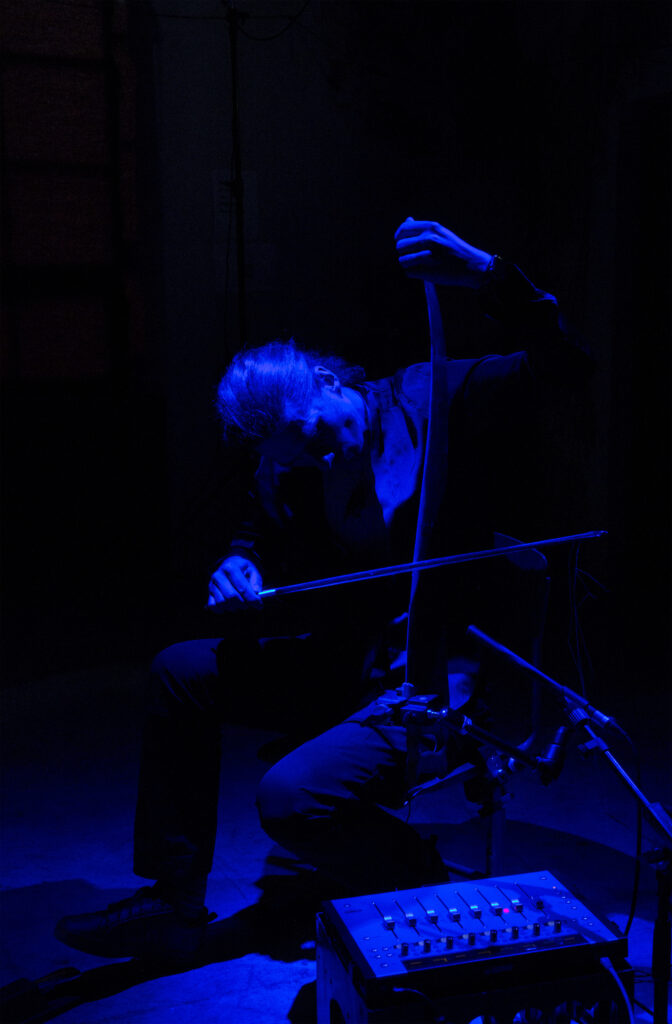Anssi Laiho is the sound designer and performer for Laboratorio — a concept developed by choreographer Milla Virtanen and video artist Leevi Lehtinen as a collection of “experiments” that can be viewed either as modules of the same piece or as independent pieces of art, each with its own theme. The first performance of Laboratorio took place in November 2021 in Kuopio, Finland.
Laboratorio Module 24, featuring Anssi performing a musical saw with live Kyma processing was performed in the Armastuse hall at Aparaaditehas in Tartu, Estonia and is dedicated to theme of identity and inspiration.
Anssi’s hardware setup, both in the studio and live on stage, consists of a Paca connected to a Metric Halo MIO2882 interface via bidirectional ADAT in a 4U mobile rack. Laiho has used this system for 10 years and finds it intuitive, because Metric Halo’s MIOconsole mixer interface gives him the opportunity to route audio between Kyma, the analog domain, and the computer in every imaginable way. When creating content as a sound designer, he often tries things out in Kyma in real-time by opening a Kyma Sound with audio input and listening to it on the spot. If it sounds good, he can route it back to his computer via MIOconsole and record it for later use.
His live setup for Laboratorio Module 24 is based on the same system setup. The aim of the hardware setup was to have as small a physical footprint as possible, because he was sharing the stage with two dancers. On stage, he had a fader-controller for the MIOconsole (to control feedback from microphones), an iPad running Kyma Control displaying performance instructions, a custom-made Raspberry Pi Wi-Fi footswitch sending OSC messages to Kyma, and a musical saw.

The instrument used in the performance is a Finnish Pikaterä Speliplari musical saw (speliplari means ‘play blade’). The instrument is designed by the Finnish musician Aarto Viljamaa. The plaintive sound of the saw is routed to Kyma through 2 microphones, which are processed by a Kyma Timeline. A custom-made piezo-contact microphone and preamp is used to create percussive and noise elements for the piece, and a small diaphragm shotgun microphone is employed for the softer harmonic material.
The way Anssi works with live electronics is by recording single notes or note patterns with multiple Kyma MemoryWriter Sounds. These sound recordings are then sampled in real-time or kept for later use in a Kyma timeline. He likes to think of this as a way of reintroducing a motive of the piece as is done in classical music composition. This also breaks the inherent tendency of adding layers when using looping samplers, which, in Anssi’s opinion, often becomes a burden for the listener at some point.
The Kyma sounds used in the performance Timeline are focused on capturing and resampling the sound played on the saw and controlling the parameters of these Sounds live, in timeline automation, presets, or through algorithmic changes programmed in Capytalk.
Laiho’s starting point for the design was to create random harmonies and arpeggiations that could then be used as accompaniment for an improvised melody. For this, he used the Live Looper from the Kyma Sound Library and added a Capytalk expression to its Rate parameter that selects a new frequency from a predefined selection of frequencies (intervals relative to a predefined starting note) to create modal harmony. He also created a quadrophonic version of the Looper and controlled the Angle parameter of each loop with a controlled random Capytalk expression that makes each individual note travel around the space.
Another Sound used in the performance is one he created a long time ago named Retrosampler. This sound captures only a very short sample of live sound and creates 4 replicated loops, each less than 1 second long. Each replicated sample has its own parameters that he controls with presets. This, together with the sine wave quality of the saw, creates a result that resembles a beeping sine wave analog synthesizer. The sound is replicated four times so he has the possibility to play 16 samples if he to presses “capture” 4 times.
The Retrosampler sound is also quadraphonic and its parameters are controlled by presets. His favorite preset is called “Line Busy” which is exactly what it sounds like. [Editor’s note: the question is which busy signal?]
For the noise and percussion parts of the performance, he used a sound called LiveCyclicGrainSampler, which is a recreation of an example from Jeffrey Stolet’s Kyma and the SumOfSines Disco Club book. This sound consists of a live looping MemoryWriter as a source for granular reverb and 5 samples with individual angle and rate parameter settings. These parameters were then controlled with timeline automation to create variation in the patterns they create.
Anssi also used his two favorite reverbs in the live processing: the NeverEngine Labs Stereo Verb, and Johannes Regnier’s Dattorro Plate.
Kyma is also an essential part of Laiho’s sound design work in the studio. One of the tracks in the performance is called “Experiment 0420” and it is his “Laboratory experiment” of Kyma processing the sound of an aluminum heat sink from Intel i5 3570K CPU played with a guitar pick. Another scene of the performance contains a song called “Tesseract Song” that is composed of an erratic piano chord progression and synthetic noise looped in Kyma and accompanied by Anssi singing through a Kyma harmonizer.
The sound design for the 50-minute performance consists of 11-12 minutes of live electronics, music composed in the studio, and “Spring” by Antonio Vivaldi. The overall design goal was to create a kaleidoscopic experience where the audience is taken to new places by surprising turns of events.
